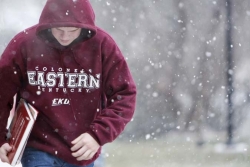Avoiding Slips, Trips, and Falls
Avoid Slips, Trips and Falls
From Bryan Makinen EKU EH&S
How do I walk safely on snow and ice?
Where appropriate, clear walking surfaces of snow and ice and use salt or its equivalent. In addition, the following precautions will help reduce the likelihood of any injuries:
- Walking on snow or ice is especially treacherous and wearing proper footwear is essential. A pair of well insulated boots with good rubber treads is a must for walking during or after a winter storm. Keeping a pair of rubber over-shoes with good treads which fit over your street shoes is a good idea during the winter months.
- When walking on an icy or snow-covered walkway, take short steps and walk at a slower pace so you can react quickly to a change in traction.
- When walking on a sidewalk which has not been cleared and you must walk in the street, walk against the traffic and as close to the curb as you can.
- Be on the lookout for vehicles which may have lost traction and are slipping towards you. Be aware that approaching vehicles may not be able to stop at crosswalks or traffic signals.
- At night, wear bright clothing or reflective gear, as dark clothing will make it difficult for motorists to see you.
- During the daytime, wear sunglasses to help you see better and avoid hazards.
http://www.osha.gov/dts/weather/winter_storm/response.html#slips_falls
Safe Winter Driving
Winter driving can be hazardous.
Prepare for the trip. Protect yourself. Prevent crashes.
PREPARE
Maintain your car. Check battery, tire tread, and windshield wipers. Keep your windows clear. Put no-freeze fluid in the washer reservoir. Check your antifreeze.
Have a flashlight, jumper cables, abrasive materials, shovel, snow brush, ice scraper, warning devices, and blankets. For long trips, add food and water, medications and a cell phone.
Plan your route. Allow plenty of time. Be familiar with maps and directions. Let others know your route and arrival time.
PROTECT YOURSELF
Buckle up and use child safety seats properly.
Get plenty of rest before a trip.
Avoid distraction and fatigue.
PREVENT CRASHES
Alcohol and drugs never mix with driving.
Slow down and increase distances between cars.
Watch for pedestrians walking in the road.
http://www.osha.gov/Publications/safeDriving.html
Contact Information
Connie Howe
connie.howe@eku.edu
859-622-5523
Published on January 28, 2013
